
R&D Transitions in Response to Digital Transformation in Korea

BangRae Lee (Center for R&D Investment and Strategy Research, Korea Institute of Science & Technology Information (KISTI), Seoul, Korea)

Dongkyu Won (Center for R&D Investment and Strategy Research, Korea Institute of Science & Technology Information (KISTI), Seoul, Korea)

Abstract
With the rapid development of the Fourth Industrial Revolution and digital transformation, scientific and technological innovation measures are being devised to overcome Korea’s low-growth, high-cost structure. Accordingly, by examining the R&D investment evaluation system of R&D PIE (R&D Platform for Investment and Evaluation), which has been promoted by the Korean government in response to the Fourth Industrial Revolution, from the perspective of R&D transformation, this study aims to explore a new path for a sustainable national science and technology innovation system following digital transformation. In particular, from the perspective of R&D PIE, a MLP (Multi-level Perspective), which had been conducted as an abstract theoretical study, was attempted with specific cases and analysis for each of the three layers: niche, landscape, and regime. In conclusion, R&D PIE was intended to elevate the abstract R&D investment evaluation system to a platform that leads innovation in the digital space of the Fourth Industrial Revolution. In addition, it was confirmed that the R&D PIE could be replaced or enhanced as a platform for innovation in response to the Fourth Industrial Revolution, thereby providing an alternative to job creation and an escape from economic crisis.
- keywords
- R&D Platform for Investment and Evaluation, multi-level perspective, Fourth Industrial Revolution, digital transformation, R&D transitions, national science and technology innovation system
1. RESEARCH BACKGROUND
The Fourth Industrial Revolution is an era of convergence in which the boundaries of physical, digital, and biological space are diluted through digital technology. Although it is an extension of the digital paradigm like the Third Industrial Revolution, it can be emphasized that the speed, scope, and economic and social impact of the change are much greater. However, with the implementation of the Korean New Deal policy after COVID-19, the emphasis of the Fourth Industrial Revolution is changing to a digital transformation.
The crisis facing the digital transformation of our industry can be said to belong to the types of system failure such as infrastructure failure, capacity failure, and interaction failure (Lee et al., 2018). Therefore, the response plan should also focus on the non-technical part, that is, infrastructure expansion, shared growth with innovation actors, and the creation of a legal and institutional environment for accommodating innovation beyond technological policies such as digitalization and simple technology dissemination or R&D subsidy support. In other words, a new paradigm beyond digitalization aimed at increasing efficiency and productivity, and digital transformation of all elements to create a new industry, are both necessary.
In particular, in terms of national R&D, it is necessary to ensure that the virtuous cycle system of national R&D investment and innovation based on data in response to the Fourth Industrial Revolution works properly. An important characteristic of the Fourth Industrial Revolution based on DNA (Data-Network-AI) is to build an organic innovation platform emphasizing ‘value connectivity.’ While discovering a new field that converges existing technologies and industries, it is necessary to lead the Fourth Industrial Revolution through public-private co-evolution by removing obstacles in the institutional environment and creating incentives appropriate for industry-university-research innovation agents. Currently, Korea is making efforts to change the structure of low-growth, high-cost. Amid these difficulties, key industries need to increase their adaptability to the Fourth Industrial Revolution and enhance competitiveness suitable for the new era.
In response to the rapidly changing technological environment, government support for R&D is steadily increasing based on policies that maximize each country’s innovation capabilities. However, increased investment did not fully contribute to innovative output. The ‘quick-following’ innovation strategy that has led to Korea’s success has reached its limit. To solve these problems, the Korean government has been operating the new national R&D investment system, the R&D Platform for Investment and Evaluation (R&D PIE), since September 2017 (Observatory of Public Sector Innovation, 2022). The PIE system is built for each strategic technology field and is based on big data analysis. Competition to develop new technologies and create new markets should become a new innovation strategy in response to digital transformation, not efficiency-oriented competition to lower unit prices as in the past. The R&D PIE system has the aspect of digital transformation in terms of data and technology transitions in the aspect of R&D.
In response to digital transformation and the Fourth Industrial Revolution, this study intends to suggest a direction for the establishment of a sustainable national innovation system from the perspective of technological transitions through R&D PIE.
2. PRIOR RESEARCH AND RESEARCH FRAME
2.1. Prior Research
2.1.1. Characteristics of the Fourth Industrial Revolution
Technological innovation triggered by the Fourth Industrial Revolution does not go directly from technology to the market, but is moving toward changing politics, gradually leading the economy, affecting society, and entering the market. In other words, it can be seen as a continuous process of connection of innovations that will spread in an S-shape while forming a time-series causal relationship between key elements, and change the frame of the current society (Kotler et al., 2016; see Fig. 1).
Fig. 1
Comparison of the technological flow of the existing technological innovation (dotted line) and the Fourth Industrial Revolution (S-shape). Source: Revised from Kotler et al. Sigma Books (2016).

For example, in the case of artificial intelligence (AI) and block chain technology, which are representative technologies of the Fourth Industrial Revolution, the markets have not yet been formed, so they first pass the legal regulatory framework (negative or positive), and then the national economic framework and social culture would go through the process of spreading to the market through proper adaptation. In this process, technological innovation takes place through the process of openness, cooperation, and creative convergence of ideas.
2.1.2. General Purpose Technologies
What are the strategies to actively respond to the society in which new technological transitions are expected? Technology transitions are generally understood as the process of introducing and disseminating a new technology to a market. Technology transition means that with the introduction of a new General Purpose Technology (GPT), the economy can be leveraged to the forefront of the technology at which it works. GPT is a groundbreaking technology that pushes the limits of technology outward and increases economic growth through diffusion within the economy (Ljungberg, 2016; Strohmaier & Rainer, 2013). All GPTs have three input-side characteristics: pervasiveness, technological dynamism, and creation of innovation (Bresnahan, 2010; Jovanovic & Rousseau, 2005; Lipsey et al., 2005).
Technological transitions entail changes in the composition of economic systems. This phenomenon is the concept of structural change. It must be distinguished from industrial restructuring, which is an economic change observed at a lower level. The dynamism of technology means that ‘continuous innovation efforts increase over time, benefiting existing users and encouraging more sectors to adopt improved GPT’ (Rosenberg & Trajtenberg, 2004). In other words, the GPT offers a wide range of potential improvements that are important sources of value creation in the process of technological change (Trajtenberg, 1990).
Finally, innovation creation implies that ‘technological advances in GPT allow users to earn more in innovating and improving their own skills’ (Rosenberg & Trajtenberg, 2004). Therefore, the GPT should exhibit strong complementarity with existing or potential new technologies, facilitating technological change in complementary investment and user sectors.
In other words, the diffusion of radical technology can only proceed through major institutional changes (Freeman & Perez, 1988). The economic system should then be viewed as consisting of two related subsystems: the technological economy and the social institution. In that sense, the concept of technological revolution is a comprehensive concept that encompasses not only technological innovation but also institutional innovation, including organizational, social, and political dimensions.
Thus, the economic impact of technological change must be analyzed through the transformation of the complete system that weaves technology, culture, economy, and organization: the technological economy paradigm (TEP) (Freeman & Perez, 1988). While each major technological innovation develops in a historical time and specific context, various system factors interacting in complex ways shape the evolutionary path of the technology (Verspagen, 2004).
2.1.3. Multi-level Perspectives
A sustainability transition occurs when a particular socio-technical transition is directed towards sustainability. The sustainability transition is defined by Markard et al. (2012). It is described as a long-term, multi-dimensional, and fundamental transformation process in which traditional socio-technological systems are transformed into more sustainable alternatives (Asquith et al., 2017). The general characteristics of a sustainability transition include four elements.
First, it entails profound changes along multiple dimensions: technological, organizational, political, economic, behavioral, and sociocultural (Markard et al., 2012; Rotmans et al., 2001). Second, it requires interaction between multiple actors such as industry, government, users, and social groups. Third, it is a long-term process that takes several decades to unfold (Geels, 2012; Rotmans et al., 2001). Fourth, it requires the development and dissemination of a wide range of innovations, including new technologies, policies, standards, and social practices (Geels et al., 2008).
In general, the most well-known concept and theoretical idea for exploring phenomena in the field of socio-technological change is the Multi-level Perspective (MLP) (Geels, 2010). MLP provides a holistic view of the multidimensional complexity of transformation in socio-technological systems (see Fig. 2).
Fig. 2
Conceptual diagram of multi-level perspective. Source: Revised from Asquith et al. European Environment Agency (2017, p. 24).
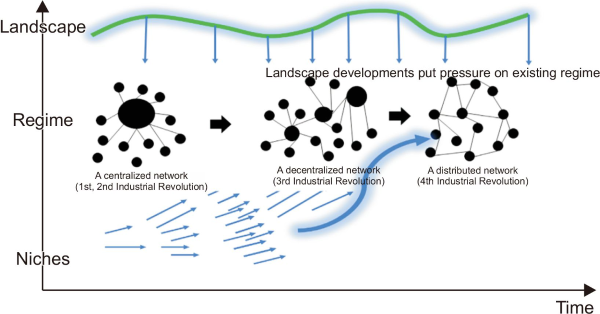
Understanding transitions in MLP occurs as a result of coevolutionary interactions between the three levels of analysis (Geels, 2010): (1) the niche level at which innovation occurs and builds momentum; (2) the socio-technological system level at which the established structures and networks of actors, institutions, and economic practices stabilize over time; and (3) the landscape level, which refers to a broader context in which major influencers such as the Fourth Industrial Revolution or global discourses such as digital transformation are happening.
The most important level in the MLP framework is the niche level. Geels (2010) describe a niche as a ‘protected space’ in which radical innovation, pioneer projects, and learning processes occur. Accommodating development can lead to new and stable socio-technological formations at the regime level. The framework concept is understood as an analytic analysis concept. While the analysis concept of social technological systems refers to tangible and measurable factors (e.g., market shares, regulations, consumption patterns), regimes are understood as more intangible analytical entities. A socio-technical framework refers to the rules and routines that are inherent in actors and lead to specific actions.
Many scholars agree that technological innovation is influenced by interactions within innovation systems (Revilla & Kiese, 2009). Technological change and interactions with institutional and organizational structures have been explored for systems at various spatial scales. In addition to the national innovation system (Nelson, 1992), representative examples include the concept of a regional innovation system (Asheim & Isaksen, 2002; Cooke, 2001).
MLP defines transition as a niche (a trajectory for radical innovation), a social-technical framework (a trajectory of established practices and related rules that stabilize existing systems), and an extrinsic socio-technical environment. Rip and Kemp (1998) and Geels (2002, 2005) consider it a non-linear process due to the interaction of development at the three levels of analysis: (1) niche innovation builds internal momentum; (2) changes in landscape level put pressure on regimes; and (3) regime destabilization creates windows of opportunity for niche innovation. The evolving interaction can be further subdivided into several stages, such as emergence, take-off, acceleration, and stabilization (Rotmans et al., 2001). Each of these steps can be associated with a specific mechanism (Geels, 2005).
A niche market here means R&D labs, subsidized pilot projects, or users with special needs and willingness to support new innovations. As a ‘protected space’ like a niche market, R&D PIE is assumed in this study. Niche markets are important for transition because they provide the seeds for systemic change. The literature on niche innovation (Kemp et al., 1998; Schot & Geels, 2008) distinguishes three key processes of niche development. The first is the alignment of expectations or visions that aim to provide guidance for innovation activities and to attract attention and funding from external actors. Second, the establishment of social networks and the registration of more agents expands the resource base of niche innovation. Third, it is a learning and coordination process at different levels, such as technology design, market demand and user preferences, infrastructure requirements, organizational issues and business models, policy tools, and symbolic meanings (Geels, 2011).
2.2. Research Frame Composition
If the above-mentioned contents are applied to R&D PIE, the accuracy of R&D investment analysis will be improved and it will be widely accepted by many ministries. The alignment of the various R&D PIE strategies and coordination processes results in a stable composition (dominant design) at the national level. And as networks grow (particularly strong actors’ participation can deliver legitimacy and resources to niche innovations), niche markets gain momentum.
The Multi-phase Concept (MPC) and MLP each consist of four distinct phases: the predevelopment phase, take-off phase, breakthrough phase, and stabilization phase, and three interacting transition levels (niche, regime, and landscape) which aim to theorize the complex transition dynamics (Chang et al., 2017).
Strategic Niche Management (SLM), which aims to identify the characteristics of successful niche markets, and Transition Management (TM), as an innovative method to solve complex social problems, have been used as research tools, but mainly to proactively influence the sustainability transition and are used as a policy tool for management.
SNM proposes three parts (articulation of expectations, the building of social networks, and a multidimensional learning process) and a niche process (Kemp et al., 1998), and TM proposes four steps to fostering new networks for sustainability (Kemp et al., 1998).
Ultimately, in order to successfully apply MLP to society, steps such as setting a transition area, developing a transition agenda, mobilizing a resulting transition network, and coordinating a vision, agenda, and coalition are necessary (Loorbach, 2010; Rotmans & Loorbach, 2009). MLP had great difficulty operating the levels in empirical studies due to poor conceptualization of the three proposed levels (i.e., niche, system, and landscape). In particular, policy makers and institutions are generally seen as part of a system that needs to change, rather than as separate actors with the power to steer society in a long-term direction. TM creates a social movement on sustainability through new alliances and networks (Loorbach & Rotmans, 2010).
In such a rapidly changing industrial environment, government R&D investment is needed for rapid and sustainable innovative growth that reflects new perspectives and methods to link and spread the accumulated strengths of the main industries, supplement the necessary capabilities, and solve the social and industrial challenges at hand. It is a reality that requires a total innovation of the system.
In addition, soft power for strengthening social, cultural, and institutional capabilities such as creativity orientation, border crossing, and deregulation should be concurrently improved.
In order to realize this, we break away from the existing R&D budget allocation and adjustment method for each project, and integrate management and evaluation of R&D projects scattered by departments by field. An investment analysis platform that is configured and supported is necessary (see Fig. 3).
Fig. 3
Conceptual diagram of research frame composition. Source: Revised from Chang et al. Sustainable Development (2017, p. 362).

3. NICHE ANALYSIS
3.1. R&D PIE
In Korea, at the Economic Ministers’ Meeting held in February 2018, “Government R&D Investment Innovation Measures to Support Innovative Growth-Introduction of Package-Type R&D Investment Platform System” was adopted as the agenda. As a Korean model that can differentiate itself from the Fourth Industrial Revolution promotion policies of advanced R&D countries, “technology-industry-manpower-policy linkage (Cross-cutting Innovation),” and its supporting system of package-type R&D investment platform (R&D PIE) construction, was adopted (see Fig. 4).
Fig. 4
Matching result of R&D PIE investment technology group (example of autonomous vehicles). R&D PIE, R&D Platform for Investment and Evaluation. Source: based on OPSI (Observatory of Public Sector Innovation). https://oecd-opsi.org/innovations/rd-platform-for-investment-and-evaluation-rd-pie.
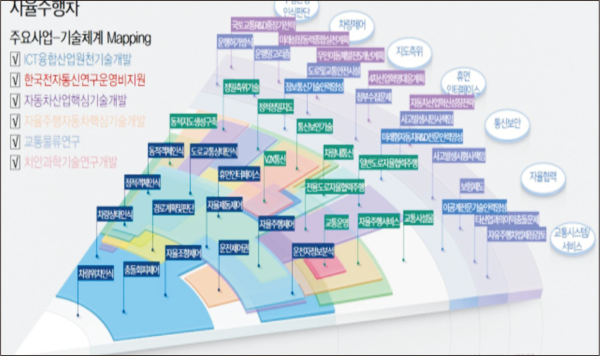
This is a cross-cutting model that is differentiated from the German model centered on manufacturing and factory (factory creates value), the US model centered on data and high-tech industries (data creates value), and the Japanese model centered on robots and human knowledge (human knowledge creates value). The key content is the evolution of the ecosystem of major industries (cross-cutting technologies create value) through the platform’s concept of ‘technology-industry-manpower-policy linkage’ (European Commission, 2014a; see Fig. 5).
Fig. 5
Example of EU cross-cutting roadmap conceptual diagram. Source: European Commission (2014a, p. 31).
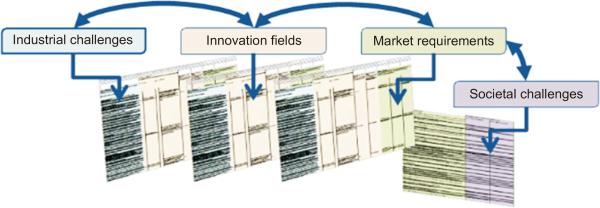
The National R&D PIE, which responds to the Fourth Industrial Revolution based on big data, selected GPTs for each field through big data analysis such as the global thesis DB (50 million cases), patent DB, and corporate DB (see Table 1).
Table 1
Package type R&D investment platform (R&D PIE) model composition
| Configuration | Contents |
|---|---|
| Classification of Technologies | Classification of core/base/convergence technologies required for industrialization in the relevant field |
| Major R&D Projects | Mapping of technology classification system and major R&D projects |
| Human Resources Development | The current status of human resource training in the relevant field being promoted by each ministry |
| Improvement of the System | Analysis of institutional issues by sector that may hinder the creation of new industries |
| Policy Information | Provision of information on implementation plans of each ministry in the relevant field, such as technology development strategies and industrial innovation policies |
The current R&D projects and the technology classification system are mapped. It is used for discovering various fields of investment necessary for setting investment direction, business planning, and performance management.
In Korea, dynamic collaborations between relevant ministries are required to realize more successful innovative growth, and it is necessary to establish a science and technology integrated data-based innovation control platform that can quickly respond to policy adjustments. In order to discuss the step-by-step implementation of R&D innovation measures and sustainable outcomes, an approach from the perspective of the national innovation system, not led by a single ministry, is required. In order to advance the innovation model, cross-ministerial linkages and cooperation are required.
R&D PIE is a platform that provides comprehensive support for ‘technology-human resource training-system-policy’ in the form of a package, breaking away from the budget allocation method for each project. We perform R&D investment decision-making support.
This was actually systemized by benchmarking the system according to the EU’s Horizon 2020 cross-cutting roadmap.
The EU identified key supporting technologies (KETs) to promote technological innovation by utilizing the cross-cutting roadmap methodology proposed in 2012. The Horizon 2020 roadmap presented the investment priorities of European Structural and Investment Funds (ESIF) and the European Investment Bank (EIB) based on KET (see Fig. 6). With a budget dedicated to KET of nearly €6 billion, Horizon 2020 was created to provide KET with high importance and visibility to promote industrial innovation and balance R&D&I (including pilot lines and demonstrators) for projects closer to the market to promote industry, through which R&D and innovation support was readjusted. Addressing clear industry and market needs across a wide range of industries, KET is recognized as helping to identify promising areas of innovation. Also, because of its systematic relevance to Europe’s ability to innovate, modernize its industrial base, and solve social challenges, the EU considers that full use of KET will ensure a social return on investment and job creation in the EU (European Commission, 2014b).
Fig. 6
Examples of the EU’s KET roadmap (Electronics and Communication Systems). KET, key supporting technology. Source: European Commission (2014b, p. 6).
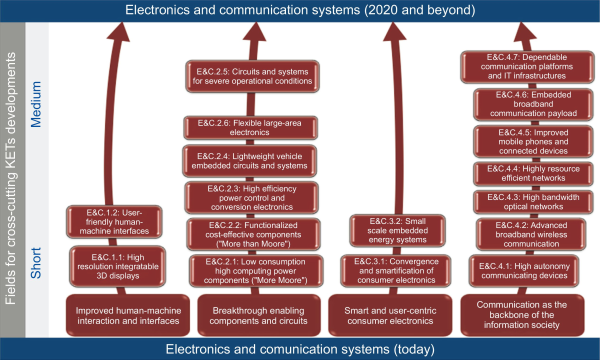
3.2. Framework of R&D PIE
In particular, a framework for enhancing R&D total factor productivity was established. In general, the rate of change of total factor productivity can be decomposed into four factors: technology, distribution, scale, and operational efficiency (Kumbhakar et al., 2000):
-
- Rate of technological change: The effect of increasing the total amount of output factors due to the pure advancement of technology
-
- Input factor distribution efficiency: Productivity improvement by lowering production cost due to the use of relatively inexpensive input factors
-
- Producer scale effect: The effect where the total amount of output factors increases as the size of the producer changes
-
- Efficiency change rate: The rate of change in the total amount of output factors generated by benchmarking the technological level of the producer with the best technology (best practice)
Existing R&D policies pursued maximization of quantitative aspects (scale efficiency) rather than qualitative aspects based on input expansion. However, in order to improve the overall efficiency of government R&D investment, improvements such as sector targeting and improvement of the operating system (technology), role differentiation and concentration (distribution) between actors, and improvement of system and execution efficiency (operation) are necessary (see Fig. 7).
Fig. 7
Conceptual diagram for improving investment efficiency of R&D PIE. R&D PIE, R&D Platform for Investment and Evaluation.
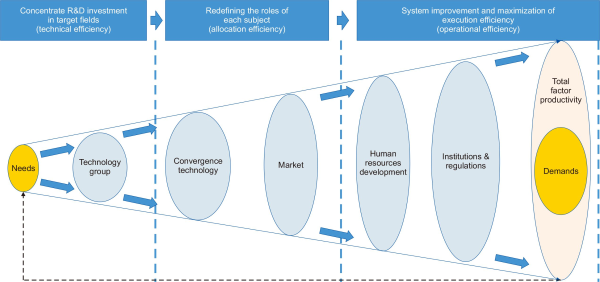
In order to improve the quality of R&D efficiency, (1) focusing R&D investment in target fields (technical efficiency), (2) re-establishing roles for each entity (distribution efficiency), and (3) improving systems and maximizing execution efficiency (operational efficiency), are required.
The R&D PIE model affects the economy for the following reasons:
-
1) It provides an evidence-based policy platform for innovation policy as well as broader public policy fields. The PIE model enables institutions to monitor, analyze, and manage technical, talent, and regulatory issues. For example, the PIE platform correlates more than 700 pollution mitigation research programs with long-term policies across eight institutions.
-
2) It improves the quality of public services to citizens. Instead of vague R&D goals, we will cluster and connect projects and design public policies at higher resolutions to realize more effective public service delivery. For example, through the PIE model, multi-ministerial personalized care plans are coordinated to add improvements to the national health care provider system.
-
3) Above all, trust is increased in the government’s innovation policy, bringing together innovation stakeholders.
3.3. Application Process of R&D PIE
The R&D PIE searches for fields requiring investment, which consists of searching for patents and theses by technology group, linking technology and industry, extracting indicators, and deriving fields requiring investment. We collected domestic and overseas publication trend information of patent and thesis information, and extracted indicators (employment inducement coefficient, value-added inducement coefficient, forward industry linkage effect, backward industry linkage effect) according to technology and industry linkage logic. In addition, the investment field was derived by considering the R&D investment amount information for the past five years (see Fig. 8).
Fig. 8
Application process of R&D PIE. R&D PIE, R&D Platform for Investment and Evaluation; GPT, General Purpose Technology; IPC, International Patent Classification.

According to the results of establishing a package-type R&D investment strategy conducted by Korea’s Science and Technology Innovation Headquarters in 2021, the employment inducement coefficient in the industry-related analysis of the 16 R&D PIE fields was 8.0 to 11.3 per billion won. The value-added inducement coefficient was analyzed to be between 0.965 and 0.985. The induced effect was higher than the manufacturing average (employment inducement coefficient 2.285, value added inducement coefficient 0.581), and it was analyzed that this was due to an economic spill-over effect. As well, in the front-to-back linkage effect analysis that reflects the inter-industry linkage characteristics of the technology, the average back-industry linkage effect of the manufacturing industry was 1.125, while the average of the R&D PIE technology group was 1.134, which was slightly higher. The manufacturing average was 1.161, which is slightly higher than the average of the R&D PIE technology group, 1.01. In conclusion, the R&D PIE technology group showed strong characteristics of the downstream industry, which is interpreted as high in the nature of basic technology (see Fig. 9).
Fig. 9
Economic index results by investment field of R&D PIE. R&D PIE, R&D Platform for Investment and Evaluation.

In case of budget allocation and adjustment in 2021, 47 new projects were to be discovered and KRW 2.134.2 trillion invested in ten major fields (see Table 2).
Table 2
Package-type R&D budget status (application budget for 2021) (unit: billions of won)
| Future Cara) (328.3) |
Fine Dust (112.8) |
Intelligent Robots (53.7) |
Smart Farm (72.2) |
A.I. (130.7) |
| Precision Medicine (274.1) |
Unmanned Aerial Vehicles (104.8) |
Smart City (55.5) |
Renewable Energyb) (671.2) |
System Semiconductors (330.2) |
4. LANDSCAPE & REGIME ANALYSIS
4.1. Government R&D Investment and Innovative Growth Causal Map
In general, innovation refers to education and R&D. In most cases, however, innovation is the result of various learning processes embedded in everyday economic activity. Therefore, interactions that increase the efficiency of producers and interactions between users and producers are key to innovation. While traditional innovation research is concerned with the resources put into the R&D system, the innovation system takes a holistic approach. The innovation system includes institutional, organizational, social, and policy factors as well as economic factors that influence innovation. In this aspect, the approach of the innovation system must first identify the elements and analyze the relationship between the elements, and this analysis method constitutes the causal map in the system dynamics. In other words, the causal map is a schema for synthesizing causal relationships between various variables by focusing on the feedback structure, and has been used as an analysis tool in the stage before system dynamics modeling.
First, the basic development for such feedback composition in the national innovation system is as follows. First, R&D activities including national R&D investment will affect knowledge accumulation through national R&D projects, and this can lead to technological innovation or gradual productivity improvement through knowledge accumulation. Second, in general, knowledge accumulation brings technological progress and has a direct effect on growth along with labor and capital; and since knowledge accumulation and technological progress increase the return on investment of human and physical capital, it can have an indirect effect on growth by increasing the efficiency of other production factors such as labor and capital. Third, growth expansion through knowledge accumulation acts as an incentive to expand R&D investment, while allowing companies and information to secure R&D investment funds equivalent to a certain portion of GDP, thereby acting as a driving force to achieve another technological innovation. In other words, the high economic growth achieved by R&D investment leads to an increase in R&D investment in the private and public sectors again through an increase in corporate profits and an increase in the government budget. Lundvall (1992) called this phenomenon a ‘cumulative causation’ between technology and growth. He argued that R&D and technological innovation enhance a country’s technological capability and bring economic growth through capital accumulation, which in turn becomes an investment resource for advanced technology and an incentive (Pianta, 1995).
On the other hand, technological progress can be further promoted through institutional factors, particularly the feedback process of regulatory reform. Technologically advanced companies will erode the market share of existing monopolies, which will lead to relaxation of monopoly regulations. In addition, deregulation will stimulate technological innovation and bring about a reduction in product prices and diffusion of core technologies through rapid improvement in productivity.
The current economic crisis in Korea is a link that leads to ‘innovative growth & Fourth Industrial Revolution enhancement → scientific and technological innovation → innovative ideas → activation of technology convergence (innovative knowledge accumulation) → technological innovation’ as shown in Fig. 10. This is due to the fact that the government is implementing the lagging indicators such as deregulation and job creation in a ‘weak or missing state.’ In the new national science and technology innovation system (application of R&D PIE) that responds to digital transformation, ‘R&D investment → knowledge accumulation → innovative growth and enhancement of the Fourth Industrial Revolution → technological innovation and convergence activation → improvement of total factor productivity.’ The virtuous cycle mechanism that leads to job creation → economic growth → new R&D investment is working. Here, innovation and job creation based on the Fourth Industrial Revolution play the role of an intermediate chain leading to the final result, the creation of national wealth. The framework that normally connects this missing link is the concept of “Cross-cutting Innovation” applying R&D PIE.
Fig. 10
Causal map of the national science and technology innovation system. R&D PIE, R&D Platform for Investment and Evaluation.
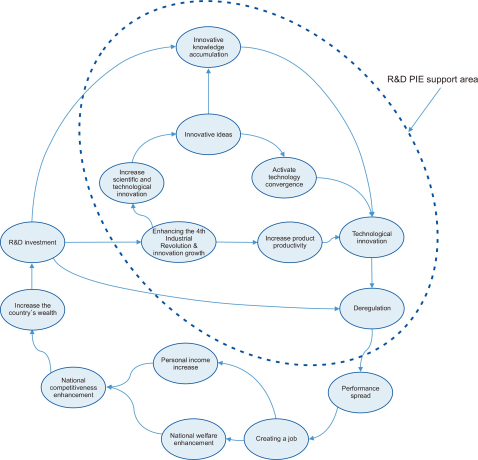
4.2. Analysis of Simulation Results
In the simulation model, ‘National R&D Investment,’ ‘Ecosystem Value Chain Linkage Level,’ ‘4th Industrial Revolution Level,’ ‘Technology Convergence, ‘Technology Innovation,’ ‘Job Creation,’ ‘National Welfare,’ ‘National Competitiveness,’ etc. of the variables appear as stock variables, and the remaining variables were regarded as flow or auxiliary variables (see Appendix).
In particular, the four index values, ‘Index of Package,’ ‘New Idea Effect,’ ‘Employment Creation Effect,’ and ‘Promoting Commercialization,’ which can be seen as effects by applying R&D PIE, were set to the highest (0.9) and lowest (0.1) values. Sensitivity analysis of the R&D conversion effect according to successful application of R&D PIE was conducted (see Fig. 11).
It is the result of computer simulation when all the initial and exponential values of the stock level in the model are 0.1 and 0.9. In the simulation results, the trend of national competitiveness and job creation, which are low-volume (level variables), is expressed over time. This is because national competitiveness and job creation indicators are representative indices that determine the remaining stock level. The values of each storage variable in Fig. 11 do not mean values in the real world. In the world of equalized units, it refers to the value calculated by simulating on the computer when each variable is converted to the basic relation equal unit modeling method with a qualitative scale ranging from 0 to 1 from a general point of view. In the case of the simulation of the effect of applying R&D PIE, assuming an index value of 0.9 as a result of the simulation, the job creation effect and driving national competitiveness exceeded 0.8 around 28 months, and national competitiveness exceeded 0.8 after 56 months. On the other hand, in the case where the R&D PIE, which assumed an index value of 0.1, was not applied in the simulation, job creation drives national competitiveness during the first 62 months, and after that, job creation slows down and national competitiveness exceeds job creation. All of them could not rise anymore and appeared to be in a state of equilibrium (see Fig. 12).
Fig. 12
Sensitivity analysis of R&D PIE application. R&D PIE, R&D Platform for Investment and Evaluation.
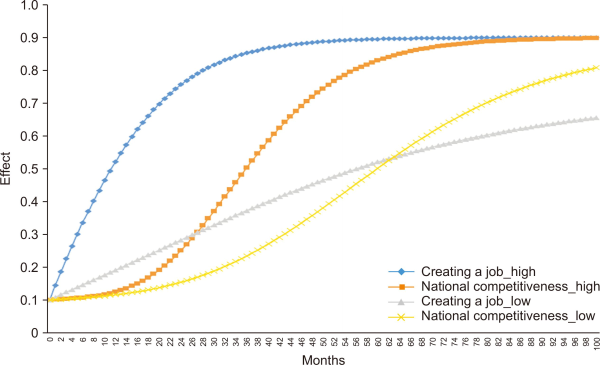
5. CONCLUSIONS AND POLICY RECOMMENDATIONS
In this paper it can be determined that the reason Korea cannot respond to the Fourth Industrial Revolution is due to the missing link in the science and technology innovation system, and it is confirmed that R&D PIE can be used to restore the missing link.
In other words, the characteristics of the Fourth Industrial Revolution are a horizontal paradigm that spreads to various fields such as ‘Politics-Economy-Society (Culture)-Market.’ In terms of establishing a framework for possible growth, a Korea-style innovation strategy in response to the Fourth Industrial Revolution was presented (tentative name) oriented to ‘Repeatedly Short-Term Cross-cutting Innovation.’ In other words, the paradigm shift from the existing “efficiency chasing strategy” to “innovation chasing strategy” is to enable autonomous innovation and competition through the construction of a data-based science and technology innovation platform.
Although many innovation models have been developed so far and the concept of the national innovation system has been refined, the reality of research in this field in Korea is that there are still very few studies.
The reason why it is difficult to study the system design and dynamics of the national science and technology innovation system is that even if the system is designed to mitigate the identified market failures, there is a possibility that the system failures will still remain, and rather, the healing of market failures will be difficult. There is a concern that it may cause other system failures (Edquist, 1997).
Although innovation is affected through the combination of various policies, individual policies that are not based on the national innovation system itself are promoted for individual purposes, so the process of how the actual policy works has not yet been clearly explained.
First of all, this study is thought to suggest the possibility of modeling that can be simulated by using the R&D PIE that has been practically implemented and utilized as a surrogate variable for the scientific and technological innovation system that has been discussed at the abstract conceptual level. These efforts will be of direct help to the design of the national policy system above all else, and it is expected that it will create an opportunity to prevent mistakes from the past which have resulted in the creation of several slogans and organizations without results. Second, it is judged that the low-quantity variables suggested in this study will become a nodal point that requires policy input. By identifying the position and role of each stock variable in the national innovation system and the sensitivity to the value of other stock variables, it will be possible to set various new policy alternatives and try to explain the future impact of already implemented policies. Third, it is shown that the sensitivity of major stock variables according to the strength and weakness of the competency index is very high. This means that the national R&D strategy is expected to serve as a policy lever to achieve vitalization and capacity building of the overall national innovation system with minimal effort. Fourth, in the same study, it was found that job creation leads the way until national competitiveness through technological innovation reaches a certain trajectory. Therefore, it can be seen that job creation is meaningful as a performance and target indicator for building a national innovation system.
The existing R&D system has three major problems. First, it was difficult to invest from a comprehensive and macroscopic perspective by field, as each department was implementing R&D-related technology policy, industrial policy, and manpower nurturing policy individually. Second, when planning a new project, it was promoted without reviewing the linkage with other ministries’ projects, resulting in a vicious cycle where similar and overlapping problems were repeated every year. Third, there were cases in which market entry was restricted due to excessive regulation or insufficient institutional maintenance on products and services derived from research results. However, the R&D PIE presented in this study solved the above three problems based on the MLP perspective (see Table 3).
Table 3
Comparison of R&D PIE with existing system
| MLP | Existing system | R&D PIE |
|---|---|---|
| Niche | Promising technologies selected based on the majors of the members who participated in the R&D planning committee for each field | Promising technology objectively adopted through big data analysis |
| Landscape | Allocation and adjustment of budget focused on individual projects | Organized package-type budgets by field |
| Partition-type business planning by department | Inter-ministerial planning | |
| Regime | Use of fragmentary and limited information | Big data-based analytics |
| No linkage between R&D and system improvement | Linking institutional improvement performance with R&D investment | |
| Project evaluation from the perspective of budget efficiency | Introduction of strategic evaluation by field |
As a result, the introduction of the R&D PIE has contributed to expanding the openness of R&D project planning, strengthening the linkage between human resource development-system-policy and R&D investment, and enhancing R&D evaluation results and performance utilization.
This study started from the point of view that the innovation platform for the Fourth Industrial Revolution should be the core target of the new government’s science and technology policy. The focus of this study is to improve R&D PIE as a platform that leads innovation in response to changes in the Fourth Industrial Revolution from an abstract R&D investment evaluation system. In addition to escaping from creation and economic crises, the goal is to come up with alternatives to improve the competitiveness and quality of life of countries, businesses, and families. The AI-based Fourth Industrial Revolution refers to a socially mature economic system in which the creation-distribution-connection-utilization-learning system is institutionalized at the national level. In particular, in a knowledge-based creative society, it is necessary to build a system that maximizes the rate of knowledge transformation and creation that enables creativity.
REFERENCES
Observatory of Public Sector Innovation (2022) R&D Platform for Investment and Evaluation ("R&D PIE") https://oecd-opsi.org/innovations/rd-platform-for-investment-and-evaluation-rd-pie/
- Submission Date
- 2022-04-25
- Revised Date
- 2022-05-06
- Accepted Date
- 2022-05-17
- 489Downloaded
- 969Viewed
- 0KCI Citations
- 0WOS Citations
.png)

